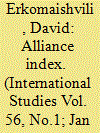| Srl | Item |
| 1 |
ID:
166025


|
|
|
|
|
| Summary/Abstract |
Orthodox approaches developed by Alliance Theory to study alliances are characterized by static and state-centric focus, which exposes theory’s logical limitations. In contrast, modern alignments are marked by continuous oscillations. Alignment stability—according to orthodox Alliance Theory—may be altogether misleading for the explanation of behaviour in alignment. This article theoretically re-conceptualizes the key notion of the orthodox Alliance Theory—the concept of alliance. Building on the basis of isolated but significant fragments of advanced research, the theoretical essence of the Alliance Theory is adjusted to encompass alignment process. Importantly, such a re-calibration bears in on an overlooked element common to all alignments—fluidity. Theoretical modification resulted in two important outcomes. First, the change of the vantage point in explaining alignments theoretically extends the orthodox Alliance Theory’s traditionally limited applicability, which excluded subnational and non-state actors. Second, the change allowed reviewing the essence of alignments focusing on a persistently evolving process, rather than on alignments’ institutional image. Sustained realignment, upgrading or downgrading of cooperative relations between actors and concurrent alignment to rival parties is no more confusing in explaining alignments. The article develops an alignment index and calculates it for the post-Soviet space.
|
|
|
|
|
|
|
|
|
|
|
|
|
|
|
|
| 2 |
ID:
096855


|
|
|
|
|
| Publication |
2009.
|
| Summary/Abstract |
This article suggests that the asymmetry of capabilities underlying the transatlantic partnership is NATO's main source of stability. Drawing on insights from mainstream political Realism, we stress the virtues of asymmetry (i.e. providing the allies with a wide bargaining space, increasing the cost of defiance and reducing intra-allied competition). The presence of these characteristics gives member states the incentive to prolong the convergence of their otherwise different political interests. In light of this theoretical model, we formulate some policy prescriptions. In particular, we argue that the USA and European countries should continue developing their own particular areas of expertise - i.e. implementing a functional division of labour. Therefore, contrary to widespread opinion, we conclude that the transatlantic military gap shall not be conceived as a burden, but rather as a key asset for the preservation of NATO's effectiveness.
|
|
|
|
|
|
|
|
|
|
|
|
|
|
|
|